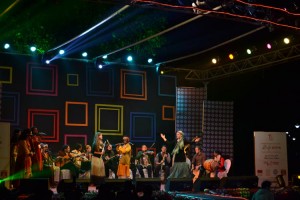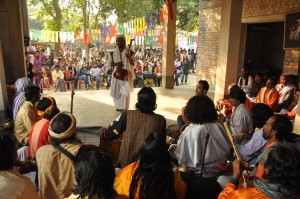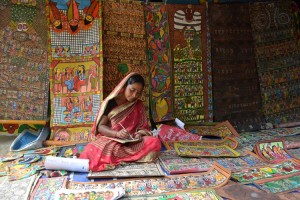By Ananya Bhattacharya, Director www.banglanatak.com
Preface
The international community now acknowledges culture as a ‘driver and enabler of development’ and its critical role in supporting socio-economic development and social inclusion. In this article I have shared our learning from our initiative in two states in eastern Indian where investment in revival of art traditions led to socio economic empowerment of the communities. The next section takes a look at standard setting instruments and international initiatives for integrating cultural dimensions in developmental framework. In the final section we examine the possible role and areas of action for NGOs working for safeguarding ICH so as to foster sustainable development using cultural capital as assets for transformative action.
Culture & Sustainable Development
Sustainable development implies equitable environmental, economic and social well being for today and tomorrow. Cultural heritage, creative industries, sustainable cultural tourism and cultural infrastructure contribute to improved income and job opportunities especially for women who are the traditional bearers of ICH and youth. As per UNCTAD data published in May, 2013, total world trade of creative goods and services amounted to US$624 billion. (UNDP, 2013). Cultural tourism is an interesting case study. With number of annual tourists exceeding one billion, tourism represents 9% of world gross domestic product (GDP), 30% of total exports and services and one out of eleven jobs. As per World Bank, 25% of tourism revenue goes to people below the poverty line in some of the poorest countries and tourism employs young people at almost twice rate than other industries. (UNGA,2014)
Revitalization of ICH leads to strengthened cultural identities, improved self esteem and pride among the indigenous communities leading to social inclusion. The process empowers marginalized communities to participate fully in social and cultural life and they get a platform for acting as social and political agency. Increased social capital and active citizenship foster inclusive development. As Irina Bokova said in a recent debate on Culture and Development, “Culture can foster participation and craft a more balanced and meaningful development model for the people and by the people.” (UNGA,2014)
Multicultural exchange and interaction through festivals, collaborative art workshops and cultural tourism promote cultural pluralism, social cohesion and peace through multicultural dialogue leading to shared understanding and greater empathy for the ‘other’. Global partnerships forged through transnational flow of creativity, multi cultural and multi national dialogue and exchange give people the right to access their own heritage as well as that of others.
Protection and preservation of cultural diversity, biodiversity and rejuvenation of traditional systems of resource management contribute to environmental sustainability. In Africa for example, traditional leaders and doctors are vital in gaining confidence to strengthen the health care sector, to combat HIV and to enhance education (UNGA:2014). Culture based livelihoods and enterprise also contribute to green economy as they are inherently based on intellectual resources and entail low resource consumption. Quality education enriched by culture transmits shared values, knowledge and skills and supports lifelong learning.
Art for Life: A Case Study from India
‘Art for Life’ or AFL is an initiative by a social enterprise, banglanatak dot com, working across India with a mission of fostering sustainable and equitable development. Under the trading style of banglanatak dot com, the organization is a hybrid entity. It is a social business and Contact Base is a not for profit organization formed by the employees. Contact Base is in consultative status with the Intangible Cultural Heritage Committee of UNESCO (2010) and in Special Consultative Status with UN ECOSOC (2013). Contact Base also has a partnership with UNESCO, New Delhi for replication of AFL model across India. Driven by the idea that poverty is caused by lack of cognizable livelihood ‘skill’, the organization initiated AFL in 2004 with 3200 folk artists living in the state of West Bengal (in eastern India). The aim was to develop an eco-system for revival and rejuvenation of traditional art skills as livelihood. The project was supported by the Eastern Zonal Cultural Centre, an autonomous institution under the Ministry of Culture, Government of India. It was funded as a special project under the rural livelihood scheme of the Government of India (2005-2008). European Union supported initiatives for facilitating multi cultural exchange and development of community led creative hubs during 2009-11. The model was replicated in the neighbouring state of Bihar (supported by the state government’s ‘Bihar State Rural Livelihood Project’ with 1500 people). In 2014, AFL was awarded second prize for innovative practice in the non farm sector at the Bihar Innovation Forum –II (supported by World Bank).

Sufi sutra, a festival of peace and traditional music
Methodology and Approach
At all stages, the key strategy is ensuring the participation of the exponents of the art forms or the living treasures in planning and implementation. As for example, training plans are drawn up by the local teachers (gurus) and leading artists in each of the art forms in a workshop where they interacted with contemporary artists to learn about market trends and demands. Participation of the exponents also address pitfalls like commoditization of culture to cater to market. At West Bengal and Bihar three to six months of training programmes were organized at the village level under the local art exponents and gurus involving the participation of all the 4700 beneficiaries to strengthen basic art skills. This was followed by creative interactions between the folk artists and contemporary musicians, theatre directors, choreographers and designers in order to innovate ways of improving the marketability of the traditional art forms. Exposure and interaction helped the folk artists to understand the dynamics of culture, place and society in different environments. They gained confidence and have increased ability to understand their own cultural context and innovate. They became ‘artistic’ in the modern sense. The outcome has been the creation of an organic, growth-oriented process where the art forms and the artistic communities, through strategic intervention and resources, are encouraged to evolve and flow, even while retaining the traditional elements of their art intact.
The various song, dance, music and visual art traditions have been documented using video to promote awareness. Festivals are used as a tool for promotion and to develop new audiences. Six local community resource centers have been established as seats of learning, practice and dissemination. The establishment of community resource centers and the organization of village festivals constituted a particularly important component of promotion of the art forms as livelihood. A two pronged strategy of bringing audiences to the villages, in addition to sending rural artists to attend fairs and festivals at diverse levels has been effective in establishing direct market linkages. The approach of developing artists’ villages as creative hubs provided a new positive identity to their localities rather than deprived rural villages. The emergence of the villages as decentralized growth poles also led to additional income opportunities to the larger community. While the status of the individuals changed from ‘daily labourer’ to ‘artist’, the villages transitioned from economically marginalized areas to cultural destinations. The model of villages as cultural destinations has been appreciated by the state governments and was dovetailed with schemes for rural tourism, leading to their sustenance beyond the project period.
Recognition of culture as skill and investments to develop local creative enterprise have generated shared resources for poverty alleviation of the community. As a result of inclusion and strengthened identity, the people have come forward to lead their own development. This led to attaining of MDG goals ranging from poverty alleviation, women empowerment to improved health, education, sanitation and even fostering of global partnerships for strengthening cultural exchange. As summarized below, culture in all its dimensions is a fundamental component of sustainable development.
Culture → Skill → Enterprise → Resource generation → Sharing
Culture → Skill → Identity → Owning development charters→ Impact on MDGs
Culture → Recognition → Social Inclusion → Pride → Safeguarding→ Aspiration
Investment on Culture → Dev of eco-system → Growth → Sustainable Development
AFL shows how once the community begets engagement and economic gain, gains pride and recognition; they protect, value and grow with their culture. For sustainable development, culture needs to be given its due recognition as assets for planning equitable economic growth, strengthening cultural pluralism and social cohesion, ensuring social, economic and environmental sustainability. For poverty alleviation, investment in culture thus needs to address skill development, promotion, capacity building of the artist communities, especially women, youth and minorities and creating enabling ecosystem for development of culture based enterprise. Culture demands greater priority and investment. Planners and policy makers at international and national levels need to be made aware of its potential and mobilized. Portability of this model is also high, as the process involved is agnostic to the art form per se. There is also need for developing partnership with academics for strengthening research on the role of culture in fostering equitable development.
Impact of AFL
AFL has established a model for professionalization of art skills leading to augmented income opportunities for artists. During the project initiation stage the art forms were dying owing to lack of opportunity to perform or practice. There was little respect or recognition for the artists and the youth at large had lost interest to learn their traditions. There was meager or no income from the art forms. The initiative has covered around 12 folk songs and dance, folk theatre and folk painting traditions of West Bengal and Bihar and all the art forms are today rejuvenated. Indicators are improved opportunity to perform, improved income from performance, lower average age of artists with the young taking interest, rejuvenation of the skill transmission systems, increased number of artist groups practicing and performing together and greater awareness on the art forms. The artists are nowadays connected to diverse networks, ranging from local to international, providing patronage and support. The platforms for showcasing vary from traditional to new innovations. As for example, scroll painters of Bengal called Patuas are commissioned to paint on new themes and even illustrations for comics. Bauls & Fakirs who sing about attaining the divine through love for humanity have found a place in international Sufi Festivals.
Cultural capital of the artist communities in West Bengal where AFL was initiated in 2004 has become an asset for local development. The monthly income for the 3200 families in West Bengal has increased from less than 10 US$ in 2005 to 80-120 US$ in 2013. The leading Patachitra painters or Fakiri singers now earn on an average 300-500 US$ per month. Purulia Chau is a subgenre of the wider Chau dance tradition, which is popular throughout the Chotonagpur Plateau region of Eastern India and was inscribed in UNESCO’s Representative List of Intangible Cultural Heritage of Humanity in 2010. When the project started despite the international fame and popularity of this vigorous dance style, the artists suffered abject poverty. They were mostly share croppers or daily labourers. There were few regular groups in Purulia and the artists were assembled only when the group leader received invitations for performance. Today there are more than 150 formally organized Chau groups. Their average fee per show has increased from 80 US$ in 2004 to 300 US$ in 2013. Acclaimed groups earn 500 US$ per show when performing in a big city. Previously the dancers had to out migrate for work in the dry season while now they earn their living as dancers.
AFL has also led to inclusive development. As income opportunities improve, the confidence of folk artists increases and they gain public respect. This encourages the artists to integrate more fully in society and take part in the development process. The Bauls and Fakirs for example had been traditionally a target of mistrust and harassment by mainstream orthodox society due to their practice of free society living. Their children were earlier often not allowed to enter school. As the popularity of their music has grown through the project intervention, Baul-Fakir musicians have now acquired a new identity. The artists have travelled to Europe, Africa and various Asian countries and have become the pride of the villagers. The villages have evolved as cultural tourism destinations. The annual village Fakiri fair at Gorbhanga draws tourists from across the globe. Other outcomes of AFL interventions are improved quality of life in terms of living condition, health, sanitation and access to electricity, improvement in school education for the children, improved mobility and socio economic status of women. Development of micro economies centering local cultural assets have also led to reduced migration.
Culture and Post-2015 Development Framework
Today we are in a critical phase in human development, when nations are reviewing their progress towards Millennium Development Goals (MDGs) and shaping a new post 2015 development agenda. There has been a paradigm shift in development strategies which are moving away from industrial/ production intensive models to human centered sustainable approaches. When the MDGs were adopted in 2000 by the United Nations General Assembly in its resolution 55/2 the importance of culture was not explicitly recognized. However since then several instruments have been adopted by the international community to strengthen the linkage between culture and development.
UNESCO approved the Universal Declaration on Cultural Diversity (2001), the convention for Safeguarding Intangible Cultural Heritage (2003) and the Convention on the Diversity of Cultural Expressions (2005). Reports have been prepared by UNDP and UNCATD on culture and development and creative economy. The Outcome Document of the 2010 MDG Summit recognized the contribution of culture in achieving MDGs. The UN General Assembly Resolutions in 2010 (65/166) and 2011 (66/208) recommended mainstreaming of culture into development policies and strategies. The increasing trend of integration of culture in development agenda is manifested at the level of United Nations Development Assistance Framework (UNDAF) where we see culture is included in 70% of UNDAF work plans by early 2012 in comparison to 30% in the 90’s (UNESCO International Congress, 2013). The outcome document of the United Nations Conference on Sustainable Development (Rio+20) and the 2013 ECOSOC Annual Ministerial Review acknowledged the importance of culture and cultural diversity for sustainable development. The International Congress “Culture: Key to Sustainable Development” held in Hangzhou at China in May 2013, specifically focused on understanding the linkages between culture and sustainable development in view of the post-2015 development framework. The World Culture Forum held at Bali had deliberations on the impact of culture on the three dimensions of sustainable development – environmental, economic and social.
However developing a shared understanding and recognition on integrating culture explicitly in global, regional and national policy frameworks still remains a challenge. Various international cultural agencies are now advocating for recognizing culture as a fourth pillar of sustainable development in future development frameworks. So far culture is not mentioned as a focus area of the Sustainable Development Goals (SDGs). In October 2013, four global cultural organizations – the International Federation of Arts Councils and Culture Agencies, Agenda 21 for Culture, Culture Action Europe and the International Federation of Coalitions for Cultural Diversity have published a plea for the integration of culture as a Millennium Development Goal in the United Nations’ post-2015 agenda. Finally, The United Nations General Assembly adopted by consensus a resolution (68/223) on culture and sustainable development on 20 December 2013, that asks Member States and all UN organizations to “give due consideration to the role of culture and sustainable development in the elaboration of the post-2015 development agenda”. The increased attention to culture in the UN system under UNESCO’s leadership was appreciated. (UNDP, 2013, UCLG- 2013, UNGA 2013). Culture has the potential of being explicitly integrated as a target or as enabler in SDG goals like Poverty Eradication, Building Shared Prosperity & Promoting Equality, Quality Education & Lifelong learning, Gender Equality and Women Empowerment, Strengthening Global Partnership for Development, Ecosystems & Biodiversity, Creating Peaceful and Inclusive Societies etc.
Areas of Action
ICH NGOs are already working for community capacity building for management of local assets, building community based organizations/institutions and strengthening their business and managerial skills. While their role as cultural mediators have so far dealt with safeguarding and representation of heritage, they now have the significant task of raising awareness among decision makers on the importance of the cultural dimension of development policies and also enabling participation of traditional bearers and practitioners in policy making processes so that appropriate owned creative economy policies are adopted. Key areas of action as detailed in the following paragraphs are mapping of cultural resources, building evidence on socio-economic gains resulting from revitalization of cultural assets, mediation and linkage between different stakeholders including the Government and the communities and supporting capacity building for management of arts and heritage at various levels.
Mapping Cultural Resources
The community of practice on safeguarding ICH has developed standards for inventorying of ICH elements. To link cultural resources with development agenda, it is imperative to create databases on the ICH practitioners. In India, for example, there is no statistical data on the number of artists and cultural practitioners in the country nor is there any information on contribution of the cultural sector in terms of employment and GDP. The National Census of India does not have any classification for artists or crafts persons, nor does India’s National Industry Classification have any economic activity categorization pertaining to performing art or crafts. As a result the creative artistic skills of a large part of population remain mostly unrecognized. Owing to poverty and lack of scope for performance and practice in changing socio cultural environment, the practitioners stop nurturing the art form leading to loss of heritage and cultural diversity. Mapping of cultural resources including the traditional bearers and practitioners is critical not only for drawing up effective plans for revival but also identifying benchmarks for monitoring project outcomes and assessing creative talents and community assets.
Establishing enabling legislative and regulatory environment
ICH NGOs have a key role in mediating necessary conditions for flourishing of creativity, recognition of artists, artisans and traditional knowledge bearers, and addressing the needs for minorities, disadvantaged groups, indigenous people and women. Culture based development programmes have contributed to establishment of supportive legislative and regulatory frameworks. In Cambodia for example, the Living Human Treasures (LHT) concept led to the implementation of a royal decree for implementation of a national LHT system. In China a major achievement is inclusion of culture based ethnic minority development in policy recommendations for the 12th Five-Year Plan on Social and Economic Development of Ethnic Minority Areas. (MDG-F, 2013) Inequality is a challenge in creative economy. Though ideas and creativity are globally sourced, the global North has largely greater control over distribution. In India for example, although considerable efforts were made since independence for promotion of the diverse cultural heritage of the country, funding support was limited for folk arts or craft.
Countries are at present in different stages of enabling supportive policy/institutional and regulatory environment at the national level. The Creative Economy Report identifies five categories as follows:
- Countries with coherent creative economy policy having human centered approach
- Countries with consumption driven ”essentially economistic creative industry agenda”
- Countries having sector driven and/or limited frameworks despite recognition of the creative industries paradigm
- Countries which despite awareness have not adopted creative industries paradigm owing to the nature of their cultural sectors
- Countries which have not as such recognized the creative economy as such. (UNDP,2013)
Weak governance is another challenge to access of schemes and programmes which the Governments may have on offer for grass root small and medium sized creative enterprise. The latter also needs greater efforts to support value chains.
Networking and Sharing of Knowledge and Practices
Lack of evidence based analysis and absence of comprehensive statistical framework for integrating culture in development have hindered inclusion of culture in development framework. Building a knowledge community of ICH NGOs is important for access to the wealth of experience developed, sharing of best practices and tools and better alignment of strategies and action for lobbying for the inclusion of culture. Currently in absence of systematic sharing platform such knowledge is not open for public access. Knowledge management is also critical for developing clear guidance and monitoring mechanisms and capacity building ‘to identify, formulate culture and development projects and implement them through more adequate, more relevant and more informed methodologies that meet project realities and objectives directly.’ (MDG-F: 2013). The ICH NGO community can catalyze such efforts by working together to develop concrete delivery based projects along with identification of indicators for improved assessment and monitoring of impact.
Strengthening Management of Arts Organizations, Institutions and Cultural Heritage
Research and capacity building for arts management are two other areas where the ICH NGOs may contribute. Evidence building necessitates macro level research on the cultural sector and its linkage with social and economic sectors. ICH NGOs have already contributed in developing artist/community based organizations managing cultural resources and nurturing creative enterprise. By working closely with research and academic institutions they can develop networks to support interdisciplinary research and training for producing able managers and institutions.
Conclusion
ICH is all about people, so investment on ICH directly benefits communities, helps in strengthening identity as well as cultural diversity, skill development and empowerment, developing creative enterprise, and generating new resources. Thus investment on ICH is critical for achieving all 3 pillars of sustainable development and a natural corollary is the significant role of ICH NGOs. They can become catalysts in sustainable development where people can “lead the lives they have reason to value” through full participation in cultural life (UCLG,2013). Culture has the potential of developing a micro-economy, creating opportunity for transformative development where people labeled as ‘unskilled’ or ‘lacking employable skills’ in conventional development pathways become stakeholders in creative economies. ICH NGOs are equipped with knowledge, experience, resources and community linkages to innovate delivery based programmes and projects addressing both cultural rights and sustainable development aspects. Their efforts will be leveraged through creation of effective platforms for knowledge sharing and networking.
References
UNDP,2013: Creative Economy Report – Widening Local Development Pathways, UNDP/UNESCO, 2013
MDF-F,2013: Knowledge Management for Culture & Development, UNESCO & MDG-Fund,2013
UCLG,2013: Agenda 21 for Culture by UCLG Committee on culture last accessed at
http://media.ifacca.org/files/cultureasgoalweb.pdf in June,2014
UNGA,2013: Resolution 68/223 – Culture & Sustainable Development’ adopted by the General Assembly on 20 December 2013 last accessed at http://www.unesco.org/new/fileadmin/MULTIMEDIA/HQ/CLT/CLT/pdf/cultdevL69.pdf in June,2014
UNGA:2014 Thematic Debate on “Culture and Sustainable Development in the Post-2015 Development Agenda” in the 68th Session of the UN General Assembly, May,2014 last accessed at https://papersmart.unmeetings.org/en/ga/68th-session/thematic-debate-on-%E2%80%9Cculture-and-sustainable-development-in-the-post-2015-development-agenda/programme/
UNESCO International Congress,2013: http://www.unesco.org/new/en/culture/themes/culture-and-development/hangzhou-congress/about-the-congress/ last accessed in June,2014
www.ichngoforum.org last accessed in June,2014



